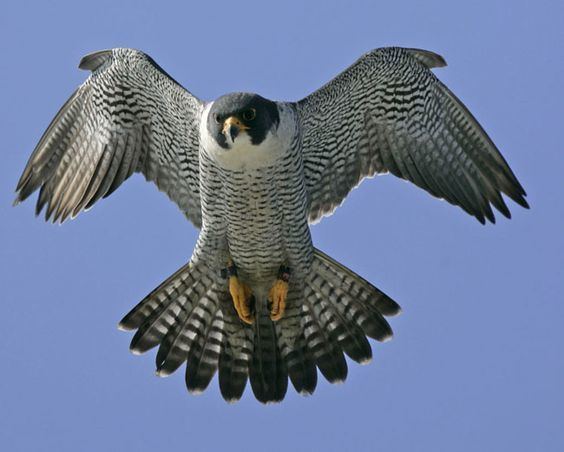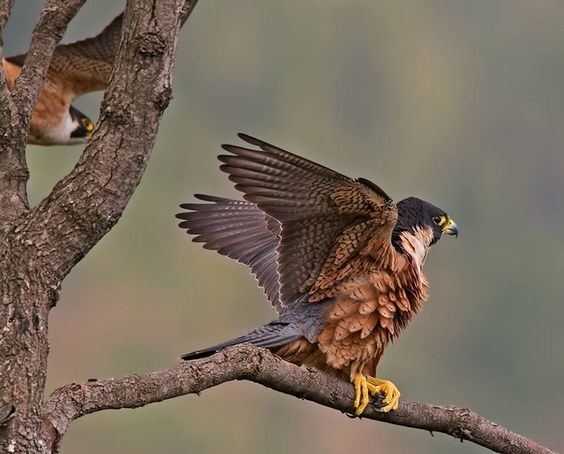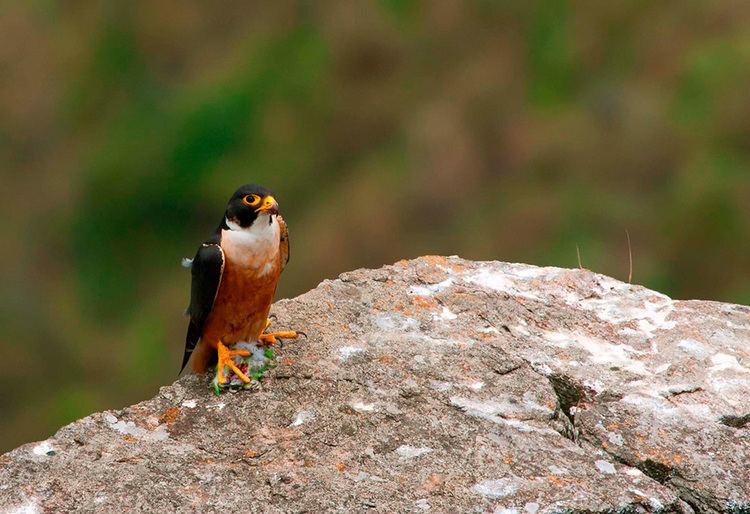Order Falconiformes | ||
 | ||
Scientific name Falco peregrinus peregrinator Similar Peregrine falcon, Bird, Falconidae, Peale's falcon, Barbary falcon | ||
Shaheen falcon
The shaheen falcon (Falco peregrinus peregrinator) is a non-migratory subspecies of the peregrine falcon found mainly in the Indian subcontinent. It has also been described as a migratory subspecies. Other common names for the subspecies include the Indian peregrine falcon, black shaheen falcon, black shaheen, Indian shaheen, or the Pakistani shaheen, and the word shaheen in these names may also be spelled as shahin.
Contents
- Shaheen falcon
- Shaheen falcon trained hunting by quynh nguyen
- Taxonomy
- Description
- Distribution and habitat
- Sri Lanka
- Ecology and behaviour
- Feeding
- Breeding
- Status
- In culture
- References

Shaheen falcon trained hunting by quynh nguyen
Taxonomy

The taxon was formally described by Carl Jakob Sundevall in 1837 as a separate species, Falco peregrinator, based on a juvenile specimen caught on a ship between Sri Lanka and the Nicobar Islands. Its taxonomic status as a subspecies of Falco peregrinus has been controversial for several years. Amidst conflicting views by ornithologists in the mid-19th century, the shaheen falcon was described as three new species: Falco shaheen from south India was described by Jerdon in 1839, Falco micrurus from Nepal and Burma was described by Hodgson in 1844, and Falco atriceps from Northern India was described by Hume in 1869. These three species were generally accepted as distinct until around the turn of the century, when all three were lumped together with Sundevall's Falco peregrinator as Falco peregrinus peregrinator.
The subspecies name peregrinator, Latin for a wanderer or habitual traveler, reflects its traveling ability.

The common English name shahin should not be confused with the same word in the Indo-European language Persian, the Turkic language Turkish, and the Afroasiatic language Arabic, where it may refer to falcons or a species of falcon. In the Indo-European language Hindi, shahin or shahin kohi refer to the female of the peregrinator subspecies, while males of the subspecies are referred to as kohila.
Description
The shaheen is a small and powerful-looking falcon with blackish upperparts, rufous underparts with fine, dark streaks, and white on the throat. The complete black face mask is sharply demarcated from the white throat. It has distinctive rufous underwing-coverts. It differs in all these features from the paler F. p. calidus, which is a scarce winter migrant to Sri Lanka. Males and females have similar markings and plumage; apart from size there is no sexual dimorphism. The birds range in length from 380 to 440 mm. The male is about the size of a house crow (Corvus splendens); the female is larger.
Distribution and habitat
The shaheen is found in South Asia from Pakistan across to India and Bangladesh in the east and to Sri Lanka, central and south-eastern China, and northern Myanmar. In India, it has been recorded in all states (except Uttar Pradesh), mainly from rocky and hilly regions. The shaheen has also been reported from the Andaman and Nicobar Islands in the Bay of Bengal.
Sri Lanka
The shaheen is the local resident species of the peregrine in Sri Lanka where it is uncommon but found throughout the island in the lowlands, and at elevations of up to 1200 m in the hill country, frequenting mountain cliffs and rock outcrops. The sheer cliff faces provide it with nest sites and serve as vantage points from which it can launch aerial strikes against fast-flying birds such as swifts. Sigiriya is a well known site for it.
Ecology and behaviour
The shaheen is usually seen as a solitary bird, or in pairs on cliffs and rock pinnacles. Peregrines typically mate for life. Because of the size difference between a male and a female, a mated pair generally hunt different prey species. It is adapted to taking prey in the air and can achieve a speed of 240 kmh in level flight; when diving after prey it can exceed speeds of 320 kmh (200 mph).
Feeding
Shaheens mostly hunt small birds, though medium-sized birds such as pigeons and parrots are also taken. Strong and fast, they dive from great heights to strike prey with their talons. If the impact does not kill the prey, the falcon bites the neck of its victim to ensure death.
Breeding
The breeding season for these birds spans from December to April. They establish their nests on elevated cliff ledges or within cavities and tunnels, laying 3-4 eggs per clutch. Chicks are ready to fledge 48 days post-hatching, with an average nesting success rate of 1.32 fledglings per nest. In India, the shaheen falcon has adapted to urban environments, with recorded instances of nesting on man-made structures, including buildings and mobile phone transmission towers.
Status
The conservation status of the shaheen in Sri Lanka is vulnerable. A preliminary population estimate of 40 breeding pairs there was made in 1996, based on a brief survey. The estimate was later corrected to 100 breeding pairs.
In culture
In Pakistani literature, the shaheen has a special association with the poetry of the country's national poet, Allama Iqbal. It also appears on the official seal of the Pakistan Air Force logo.
A misprinted 1992 Indian stamp in a "birds of prey" series showed a picture of an osprey, with the incorrect denomination and the name Shahin Kohila, the Hindi name for female shaheen falcons; one of these stamps sold for £11,500 in a 2011 London auction.
